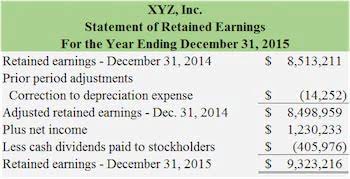
Similarly, the iPhone maker, whose fiscal year ends in September, had $70.4 billion in retained earnings as of September 2018. Retained earnings and profits are related concepts, but they’re not exactly the same. For the past 52 years, Harold Averkamp (CPA, MBA) hasworked as an accounting supervisor, manager, consultant, university instructor, and innovator in teaching accounting online. Profit is a widely monitored financial metric that is regularly used to evaluate the health of a company. We need to understand here that the revenue reserve accounting of a company isn’t just on the books of the company.
How to Reconcile Undeposited Funds in QuickBooks Online
- This retained earnings can be used for various purposes, such as reinvesting in the business, paying off debt, or funding future projects.
- One key attribute of surplus reserve is that it is a voluntary action taken by the company’s management.
- This reduction happens because dividends are considered a distribution of profits that no longer remain with the company.
- Profit is a widely monitored financial metric that is regularly used to evaluate the health of a company.
- A higher ratio indicates efficient reinvestment and asset growth, whereas a low ratio may signal underutilized resources or inefficiency.
Because the company has not created any real value simply by announcing a stock dividend, the per-share market price is adjusted according to the proportion of the stock dividend. Retained earnings are also called earnings surplus and represent reserve money, which is available to company management for reinvesting back into the business. It can reinvest this money into the business for expansion, operating expenses, research and development, acquisitions, launching new products, and more. Ultimately, the company’s management and board of directors decides how to use retained earnings. Surplus reserve and undistributed profit are both financial terms used to describe funds that a company has set aside for future use. Surplus reserve refers to the excess funds that a company has accumulated beyond its required reserves, which are typically used for investment or expansion purposes.

How to create?
A general reserve is created to meet future contingencies or for general business purposes, and a specific reserve is created for a specific purpose, such as dividends or bonuses. A secret reserve is created by underestimating the value of assets or overestimating liabilities on the company’s financial statements for internal purposes. Another important aspect of undistributed profit is that it can be used to increase the company’s equity base, which can improve its financial stability and creditworthiness. By retaining a portion of its profits as undistributed profit, Car Dealership Accounting a company can build up its equity reserves and reduce its reliance on external sources of funding. One key attribute of undistributed profit is that it represents the cumulative earnings of the company that have not been paid out to shareholders.
- We built a platform to give everyone access to the tax and wealth-building tools of the ultra-rich like Mark Zuckerberg and Phil Knight.
- When a company pays dividends to its shareholders, it reduces its retained earnings by the amount of dividends paid.
- Instead, they are retained to be reinvested in a new business opportunity, to increase inventory levels, to lower long-term debt or to increase cash reserves.
- These retained earnings are not distributed as dividends but are kept within the company for various financial purposes.
- A statement of retained earnings details the changes in a company’s retained earnings balance over a specific period, usually a year.
What are retained earnings?

Retained earnings are also known as accumulated earnings, earned surplus, undistributed profits, or retained income. – The extra money a company makes from its investments and assets, over and above the amount paid out in dividends to shareholders. In this example, the company ABC has a beginning balance of $3.3 billion and a net income of $2.7 million.
If the firm has managed to increase its shareholder equity, retaining its earnings is a good strategy. It is a key indicator of a company’s ability how is sales tax calculated to generate sales and it’s reported before deducting any expenses. Retained earnings are reported in the shareholders’ equity section of a balance sheet. Another important aspect of surplus reserve is that it is subject to certain legal and regulatory requirements.
- Undistributed profit, on the other hand, refers to the profits that a company has earned but has not yet distributed to its shareholders as dividends.
- Most software offers ready-made report templates, including a statement of retained earnings, which you can customize to fit your company’s needs.
- This non-distribution can be due to several factors, such as the company reinvesting its profits into the business.
- After the initial public offering (IPO), Apple Inc. kept all its profits as revenue reserve for a few years.
- When accumulated earnings grow, they contribute to an increase in shareholder equity, which signals financial strength.
- These programs are designed to assist small businesses with creating financial statements, including retained earnings.
Revenue Reserves
Positive retained earnings signify financial stability and the ability to reinvest in the company’s growth. This usually gives companies more options to fund expansions and other initiatives without relying on high-interest loans or other debt. Accumulated earnings are a vital resource for businesses, enabling growth, debt reduction, and financial stability. By retaining and strategically allocating profits, companies can achieve long-term success while balancing shareholder expectations. The accumulated earnings tax is imposed on companies retaining excessive profits without a valid business purpose to avoid shareholder taxation. Retaining earnings instead of paying them as dividends is often a strategic decision based on a company’s goals.
Where do I report undistributed long-term capital gains?

Both types of reserves are essential components of a company’s financial toolkit, serving different roles in ensuring financial stability and strategic growth. In this section, we will take an example to see how we can create revenue reserves from the business’s profits. Revenue, net profit, and retained earnings are terms frequently used on a company’s balance sheet, but it’s important to understand their differences. A statement of retained earnings details the changes in a company’s retained earnings balance over a specific period, usually a year. Retained earnings act as a reservoir of internal financing you can use to fund growth initiatives, finance capital expenditures, undistributed profits that have accumulated in the company over time are called repay debts, or hire new staff.
